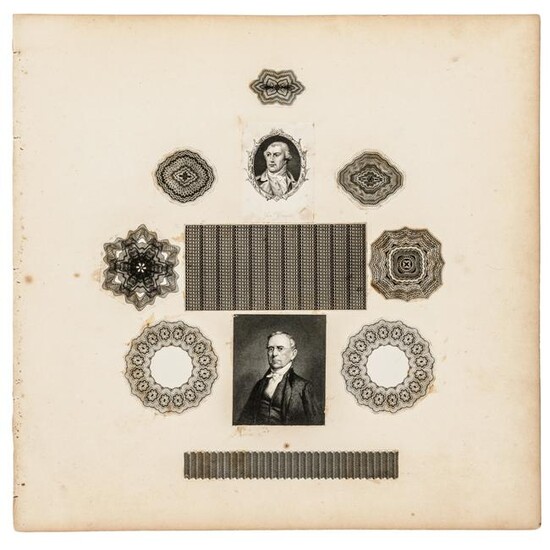Unique Durand Archive Book Vignette Display Sheet
Security Printing History
Unique Engraved Portrait of General Greene Together With Intricate Patterns & Dies Durand Archive Book
Unique Vignette Sample Display Sheet, formerly from the Cyrus Durand Archive Book, Plate 43, Portraits, Dies and Grillwork, Choice Crisp Extremely Fine.
Durand engraved plate arrangement with the patterns being quite intricate on a 10" x 10.25" heavy wove paper page. There are Eleven Elements, all printed in black. At bottom center is a large handsome Portrait of unidentified apparent Jurist (by his dress, possibly Judge Story), who is flanked by two ornate circular lathe frames, and underneath having a narrow strip of grillwork. Above,a piece of wider grillwork with repeating THREE in a micro-lettered pattern. The engraved Portrait of the historic Revolutionary War Major General Nathanael Greene is placed above, and there are still Five other decorative lathe pieces. A few petty foxing and glue specks, yet crisp and a highly interesting plate with striking portraiture.
Nathanael Greene (1742-1786). Sometimes misspelled Nathaniel, was a Major General of the Continental Army in the American Revolutionary War. He emerged from the war with a reputation as George Washington's most gifted and dependable officer, and is known for his successful command in the Southern theater of the war.
Born in Warwick, Rhode Island, Greene was elected to the Rhode Island General Assembly and ran his family's foundry. He came to oppose British rule in Rhode Island and formed a militia in 1774. The Continental Congress appointed Greene to the rank of brigadier general in the Continental Army in 1775, and promoted Greene to major general in 1776. He served as Washington's subordinate in the New York and New Jersey campaign and the Philadelphia campaign, and was the Continental Army's Quartermaster General from 1778 to 1780.
In December 1780, Greene was appointed to command the Continental Army in the southern theater of the Revolutionary War, replacing General Horatio Gates. He engaged in a successful campaign to harass the British forces under General Charles Cornwallis, limiting British control of the South to the coastal areas. After the war, he declined appointment as Secretary of War and received land grants from the Southern states. He died at his Mulberry Grove Plantation in 1786. Many places in the United States are named after Greene.
View it on
Estimate
Time, Location
Auction House
Security Printing History
Unique Engraved Portrait of General Greene Together With Intricate Patterns & Dies Durand Archive Book
Unique Vignette Sample Display Sheet, formerly from the Cyrus Durand Archive Book, Plate 43, Portraits, Dies and Grillwork, Choice Crisp Extremely Fine.
Durand engraved plate arrangement with the patterns being quite intricate on a 10" x 10.25" heavy wove paper page. There are Eleven Elements, all printed in black. At bottom center is a large handsome Portrait of unidentified apparent Jurist (by his dress, possibly Judge Story), who is flanked by two ornate circular lathe frames, and underneath having a narrow strip of grillwork. Above,a piece of wider grillwork with repeating THREE in a micro-lettered pattern. The engraved Portrait of the historic Revolutionary War Major General Nathanael Greene is placed above, and there are still Five other decorative lathe pieces. A few petty foxing and glue specks, yet crisp and a highly interesting plate with striking portraiture.
Nathanael Greene (1742-1786). Sometimes misspelled Nathaniel, was a Major General of the Continental Army in the American Revolutionary War. He emerged from the war with a reputation as George Washington's most gifted and dependable officer, and is known for his successful command in the Southern theater of the war.
Born in Warwick, Rhode Island, Greene was elected to the Rhode Island General Assembly and ran his family's foundry. He came to oppose British rule in Rhode Island and formed a militia in 1774. The Continental Congress appointed Greene to the rank of brigadier general in the Continental Army in 1775, and promoted Greene to major general in 1776. He served as Washington's subordinate in the New York and New Jersey campaign and the Philadelphia campaign, and was the Continental Army's Quartermaster General from 1778 to 1780.
In December 1780, Greene was appointed to command the Continental Army in the southern theater of the Revolutionary War, replacing General Horatio Gates. He engaged in a successful campaign to harass the British forces under General Charles Cornwallis, limiting British control of the South to the coastal areas. After the war, he declined appointment as Secretary of War and received land grants from the Southern states. He died at his Mulberry Grove Plantation in 1786. Many places in the United States are named after Greene.



